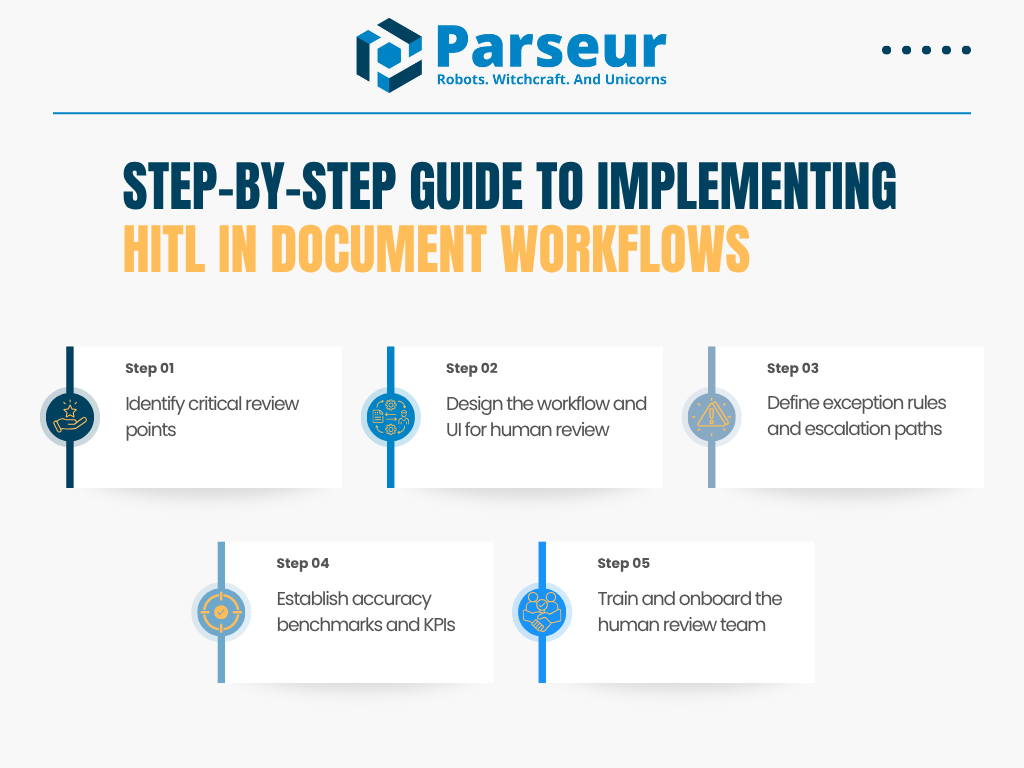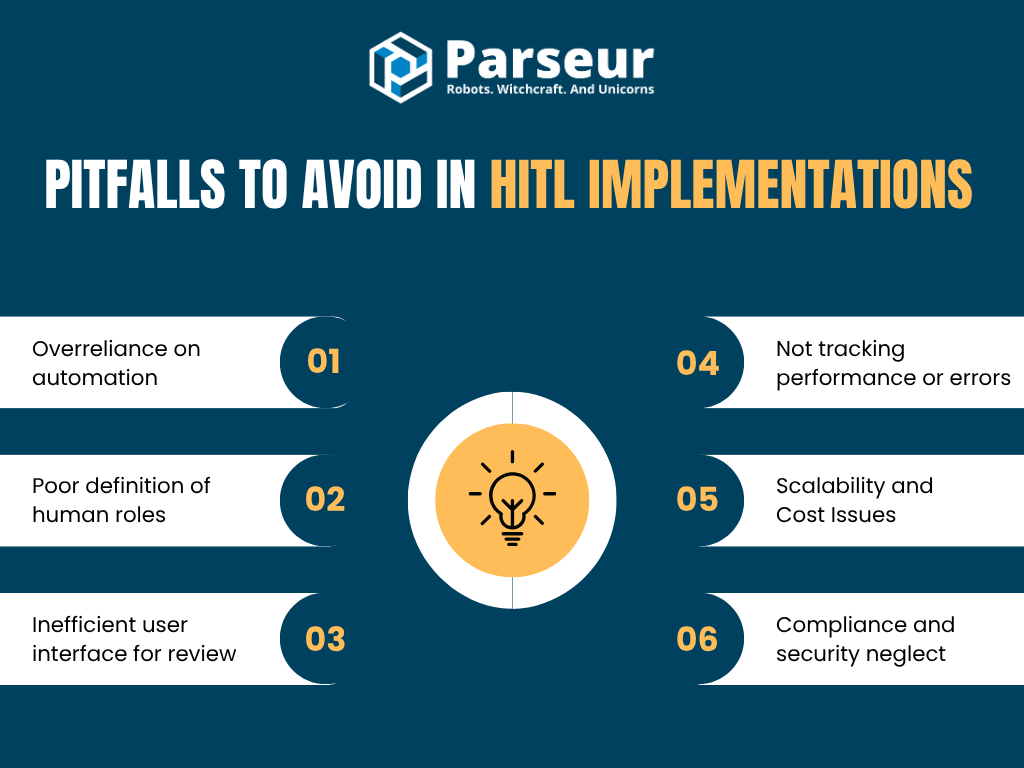Key Takeaways
- Human-in-the-loop (HITL) AI in document workflows boosts accuracy from ~80% to 95%+ by combining automation with human oversight.
- Successful HITL implementation requires clear review points, intuitive UI design, defined exception rules, and measurable KPIs.
- Common pitfalls include unclear human roles, poor review interfaces, poor performance tracking, and compliance oversights.
- A well-planned HITL system enhances trust, ensures compliance, and scales effectively with improved AI learning over time.
Why HITL Matters In Document Workflows
Human-in-the-Loop (HITL) in document workflows refers to integrating human oversight at specific points within automated processes. This approach ensures accuracy, accountability, and trust. In document processing, humans validate or correct data extracted by AI to improve reliability.
Full automation is imperfect even with powerful tools like AI Optical Character Recognition (OCR) and Intelligent Document Processing (IDP).
A study from Infrrd, highlighting the impact of HITL in document workflows, is that HITL systems can reduce document processing costs by up to 70% while significantly lowering error rates, demonstrating substantial improvements in both efficiency and accuracy when human oversight complements AI automation.
This added human involvement is essential in industries with compliance requirements, financial risks, or sensitive documentation, where small mistakes can lead to major consequences. HITL bridges the gap between automation speed and the precision that businesses require.
This practical guide will review the best practices for building HITL into your document workflows. This includes designing effective review interfaces, creating exception handling rules, and setting realistic accuracy benchmarks. We will also outline common pitfalls to avoid, helping you create a system where human-AI collaboration thrives.
To learn more about HITL AI and how it shapes automation in 2026, visit our Human-in-the-Loop AI: Definition, Benefits & 2026 Trends.
Step-by-Step Guide To Implementing HITL In Document Workflows
Implementing Human-in-the-Loop AI in document workflows requires planning, the right tools, and a clear structure. Below is a practical, step-by-step guide to building an effective HITL system for document automation.

Step 1: Identifying Critical Human Review Points in HITL Workflows
Start by determining which parts of the document workflow require human input. Focus on areas prone to errors, carrying higher risk, or where AI lacks confidence. For example, if your parser assigns a confidence score below 90% to a data field, that field should be flagged for human review.
Common review points include:
- Low-confidence fields such as totals, names, or dates
- Compliance-related fields that impact legal or audit readiness
- Business-critical data like invoice amounts or contract clauses
Using confidence thresholds helps prioritize human attention where it adds the most value.
Step 2: Designing Effective Human Review Interfaces for Document Automation
The review interface should be transparent, responsive, and efficient. It should:
- Highlight the fields that require attention
- Display the original document next to the extracted data
- Allow for fast corrections and reviewer notes
Tools like Parseur and similar IDP platforms offer user-friendly dashboards that enhance this process. An effective user interface helps reduce human error and increases processing speed.
Step 3: Defining Exception Rules and Escalation Paths Clearly
Define the business rules for when automation should pause and involve a human. This is often needed when the system encounters anomalies or incomplete data.
Examples include:
- Invoice totals that do not match the sum of the line items
- Missing or mismatched key fields, like invoice numbers or purchase orders
- Documents that do not match known formats
Create a documented “exception handbook” listing scenarios requiring manual review and procedures for escalating complex issues.
Step 4: Establishing HITL Accuracy Benchmarks & KPIs
Before launch, define measurable goals and track them regularly. Benchmarks might include:
- Percentage of documents processed without human input
- Accuracy rate after human intervention
- Time spent per document in manual review
Out-of-the-box AI often struggles with complex or unstructured data, leading to incomplete or inaccurate results. Integrating a human-in-the-loop process significantly improves the quality and reliability of output. Key performance indicators (KPIs) like automation rates, override frequency, and reviewer efficiency help evaluate the model’s performance and the overall workflow effectiveness.
Step 5: Training and Onboarding Teams for Effective Human-AI Collaboration
Ensure the human reviewers understand both the tools and the expectations. Training should cover:
- How to use the review interface effectively
- What exceptions to look for and how to flag them
- How their corrections feed back into improving the AI system
Provide checklists to help reviewers stay consistent, emphasizing that this is a continuous learning process. Their feedback should inform future model updates and improve overall automation performance.
Best Practices For HITL Workflow Success
Successfully implementing HITL AI in document workflows depends on more than just technology. It requires a structured governance approach, seamless human input integration, and continuous optimization.
According to a 2024 survey by Workday, 70% of leaders believe AI systems should be designed to allow for easy human review and intervention, yet 42% of employees say their companies lack clarity on which systems require human oversight.
Below are proven best practices to ensure your HITL system delivers long-term value.
Ensuring Clear Governance & Defined Roles in HITL Systems
Establish clear oversight policies for where, when, and how humans should intervene. Every reviewer should know their role and the exact criteria for stepping in.
According to the National Institute of Standards and Technology (NIST), ambiguity in oversight responsibilities can lead to breakdowns in HITL performance. Create documented standard operating procedures (SOPs) that define:
- Who is responsible for reviewing flagged data
- What qualifies as a review-worthy exception
- How decisions should be logged and escalated
This governance structure ensures accountability and consistent outcomes.
According to Simbo, 80% of business leaders view explainability, ethics, bias, or trust as major challenges in AI implementation, necessitating strong governance frameworks to ensure transparency and accountability in HITL systems.
Integrating Human Input Seamlessly in AI Workflows
Avoid treating human review as a last-minute patch. Instead, HITL should be designed as a native part of the automation pipeline. For example, build automatic pauses in the workflow when confidence thresholds drop below a defined value, or when business-critical data is detected.
A seamless integration allows human intervention to occur naturally and predictably, reducing friction and enhancing trust in the system.
Leveraging Efficient Tools & Interfaces for HITL
Use platforms that support intuitive, low-code human-AI collaboration. Look for features such as:
- Dashboards for real-time review
- Automated alerts for low-confidence fields
- In-app correction and annotation tools
Continuous Monitoring and Feedback for Ongoing Accuracy
Track how often humans override AI decisions, and use that data to improve the model. A feedback loop is essential for long-term accuracy gains.
Examples of useful performance metrics include:
- Override rate by field type
- Error rates before and after review
- Average time spent on manual verification
Maintain an exception log to capture recurring issues and use it to retrain your model. This allows the AI to learn from past corrections and gradually reduce the need for human intervention.
Gradual Automation & Scaling of HITL Implementations
Start small by applying HITL to a single workflow or document type. As the system proves itself and human trust increases, its coverage will expand across more use cases.
Avoid rolling out full automation all at once. A phased approach helps:
- Catch issues early before scaling
- Prevent human reviewers from being overwhelmed
- Identify bottlenecks in the interface or process
Over time, your HITL implementation should evolve into a system in which automation handles more tasks and human input focuses only on edge cases or exceptions.
Pitfalls To Avoid In HITL Implementations
While HITL AI can significantly enhance document accuracy and compliance, poor implementation can lead to inefficiency, confusion, and missed opportunities.
According to a Cyber Security Dive report, 42% of companies had to abandon most of their AI initiatives, up from just 17% the previous year, highlighting how a lack of proper human oversight and governance often leads to failed implementations.

Here are the most common mistakes organizations make and how to avoid them.
Avoiding Overreliance on Automation
One major pitfall is assuming the AI system is always correct. This can lead to “automation bias,” where human reviewers trust AI output blindly and fail to catch errors. Encourage a culture of careful verification, especially for critical fields like invoice totals, tax amounts, or personal data.
Human reviewers should feel empowered to question AI results and flag inconsistencies. HITL should always be treated as a quality control mechanism, not a rubber stamp.
Clearly Defining Human Roles to Prevent Workflow Breakdowns
If it's unclear who should review flagged data or make final decisions, workflows can break down. According to NIST, vague role assignments undermine the entire purpose of human oversight.
Avoid this by:
- Defining responsibilities clearly (for example, "verification specialist" handles flagged invoices daily)
- Creating a role-based access model for review actions
- Providing SOPs that specify exactly what needs review and how to respond
Ensuring Efficient UI to Avoid Reviewer Frustration
A cumbersome review interface slows down human reviewers and introduces errors. The review becomes frustrating and time-consuming if users have to search for data fields or manually compare values.
Best practice:
- Use tools that highlight extracted fields next to the original documents
- Ensure one-click correction functionality
- Conduct usability testing with your review team before launch
As Cloudflare notes in their documentation, an intuitive UI and persistent state can significantly reduce handling time in human-AI workflows.
Tracking Performance Metrics to Sustain HITL Effectiveness
Failing to measure how HITL is performing means you cannot improve it. Without metrics, you won’t know how often humans override AI, where the errors come from, or whether training is helping.
Avoid a “set it and forget it” approach. Instead:
- Track key metrics like override rate, accuracy after review, and turnaround time
- Maintain an exception log to spot trends
- Use this data to update confidence thresholds or retrain models
According to a survey of Digital CXOs, only 32% of machine learning models successfully move from pilot to production, underscoring how a lack of performance tracking and monitoring is a significant barrier to effective deployment.
Planning for Scalability to Prevent Resource Bottlenecks
The system may not scale with business growth if human reviewers are required for every document. What works during a pilot might collapse under volume if automation doesn’t keep improving.
To mitigate this:
- Continuously raise the automation bar by retraining models
- Increase the confidence threshold for what qualifies as “auto-processed.”
- Use data to reduce the percentage of items requiring review gradually
Also, consider reviewer bandwidth and workload balancing as part of your scaling plan.
Compliance and Security Controls for HITL Implementations
In regulated industries, human reviewers often deal with sensitive data. Without proper controls, your HITL system could create compliance or privacy risks.
To stay compliant:
- Apply access controls so that only authorized personnel can see documents
- Train reviewers on data privacy policies
- Log every human action for audit purposes, including what was changed, by whom, and when
Auditability is critical in industries like finance and healthcare, where HITL is most commonly applied.
Conclusion And Final Checklist
Human-in-the-loop (HITL) AI in document workflows offers the best of both worlds. By combining AI’s speed with human oversight, businesses can achieve higher accuracy, greater trust, and better compliance in their document processing systems. When implemented correctly, HITL workflows help avoid costly automation mistakes, ensure data integrity, and build scalable processes.
This added accuracy can be critical in finance, healthcare, and legal services, where data errors can lead to serious consequences.
To get the most out of HITL, ensure your system is well-designed, your team is properly trained, and your performance metrics are consistently tracked. Avoiding the common pitfalls outlined earlier will ensure that human-in-the-loop becomes a strength, not a bottleneck.
Quick HITL implementation checklist:
- Identify and prioritize review points in the document workflow
- Design an intuitive and efficient review interface
- Establish clear exception rules and escalation protocols
- Set performance benchmarks (accuracy rates, turnaround time)
- Train reviewers and integrate a feedback loop for continuous AI improvement
- Monitor override rates and retrain models as needed
- Plan for scalability with automation and a balance of human effort balance
- Enforce compliance controls and log all human interventions
Last updated on




